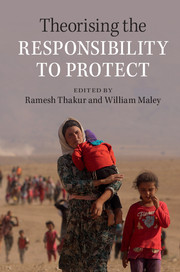Book contents
- Frontmatter
- Contents
- List of figures
- Notes on contributors
- Part I Context
- Part II The Responsibility to Protect, normative theory and global governance
- Part III The Responsibility to Protect and international social purposes
- 12 United Nations peacekeeping and the Responsibility to Protect
- 13 Humanitarian law, refugee protection and the Responsibility to Protect
- 14 Is the Responsibility to Protect doctrine gender-neutral?
- 15 The Responsibility to Protect: a Western idea?
- 16 Colonialism and the Responsibility to Protect
- Index
14 - Is the Responsibility to Protect doctrine gender-neutral?
from Part III - The Responsibility to Protect and international social purposes
Published online by Cambridge University Press: 05 August 2015
- Frontmatter
- Contents
- List of figures
- Notes on contributors
- Part I Context
- Part II The Responsibility to Protect, normative theory and global governance
- Part III The Responsibility to Protect and international social purposes
- 12 United Nations peacekeeping and the Responsibility to Protect
- 13 Humanitarian law, refugee protection and the Responsibility to Protect
- 14 Is the Responsibility to Protect doctrine gender-neutral?
- 15 The Responsibility to Protect: a Western idea?
- 16 Colonialism and the Responsibility to Protect
- Index
Summary
Introduction
On Monday [20 May 2013], terrified women and children who arrived, seeking sanctuary again, were battered away from the safety of the SANDF-Munigi base in the Congo while mortars were exploding nearby. Simone Schlindwein, of the German Tageszeitung, was ‘shocked by the remorseless way in which South African soldiers were keeping terrified refugees away from their compound’ while the fighting raged on.
Censorbugbear, online bloggerIs the Responsibility to Protect (R2P) doctrine gender-neutral? Is this the right question? Instead, should we measure if this doctrine contributes materially or theoretically to the feminist goal of gender equality; or is the doctrine flawed in its design and could its implementation cause or exacerbate harm to women and girls involved in conflict? What would the R2P doctrine mean to the terrified women and girls seeking refuge at the UN compound as described above?
In 2010, Australian jurist Hilary Charlesworth published a seminal article entitled ‘Feminist Reflections on the Responsibility to Protect’ in the lead journal Global Responsibility to Protect. At that juncture, she found that it was ‘worth engaging with concepts such as the Responsibility to Protect because they can unsettle the standard boundaries of the discipline and increase the possibility of its transformation’ but that the design of the R2P doctrine has been ‘influenced by men's lives and the dominance of masculine modes of reasoning'. In 2010, this article was one of very few examples of feminist engagement with the R2P doctrine, with almost no engagement in the reverse direction from R2P scholars. It built in turn upon a pivotal UN INSTRAW report in 2006. I review international developments from 2009 to 2014 to re-examine this proposition and view R2P through a variety of feminist reactions.
Based on this analysis, I argue that the experience of armed and societal conflict is gendered, which has been plainly accepted by the Security Council in relation to the women, peace and security agenda. Therefore, R2P cannot claim nor should it pretend gender-neutrality in its response to conflict, and if it does, or simply ignores gender issues or continually relegates women to the category of ‘vulnerable populations’, its proponents risk losing credibility. In 2010, Charlesworth's analysis was that the doctrine in fact offers ‘gendered and racialised accounts of peace and conflict and the capacity of intervention to defuse violence’.
- Type
- Chapter
- Information
- Theorising the Responsibility to Protect , pp. 266 - 284Publisher: Cambridge University PressPrint publication year: 2015
- 2
- Cited by



